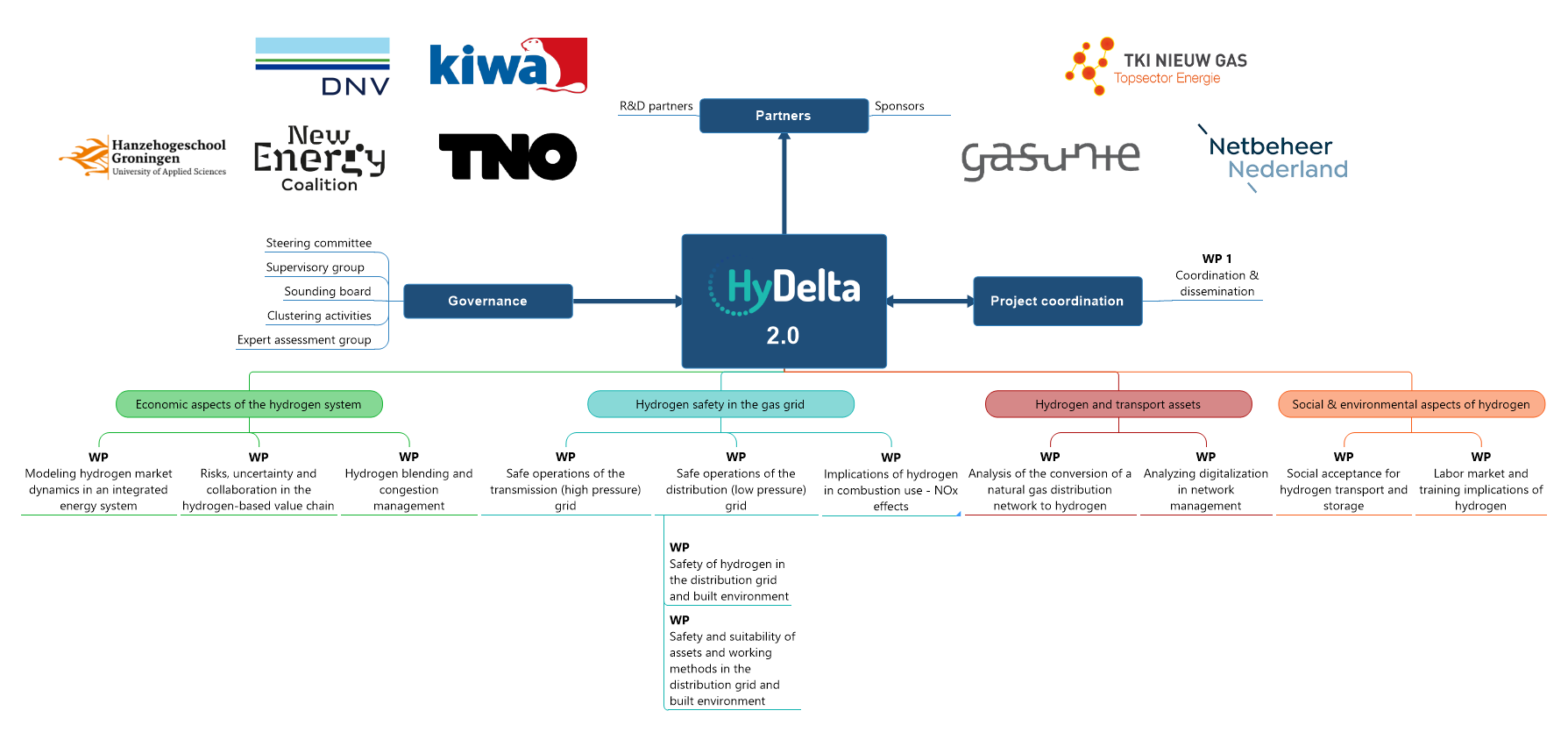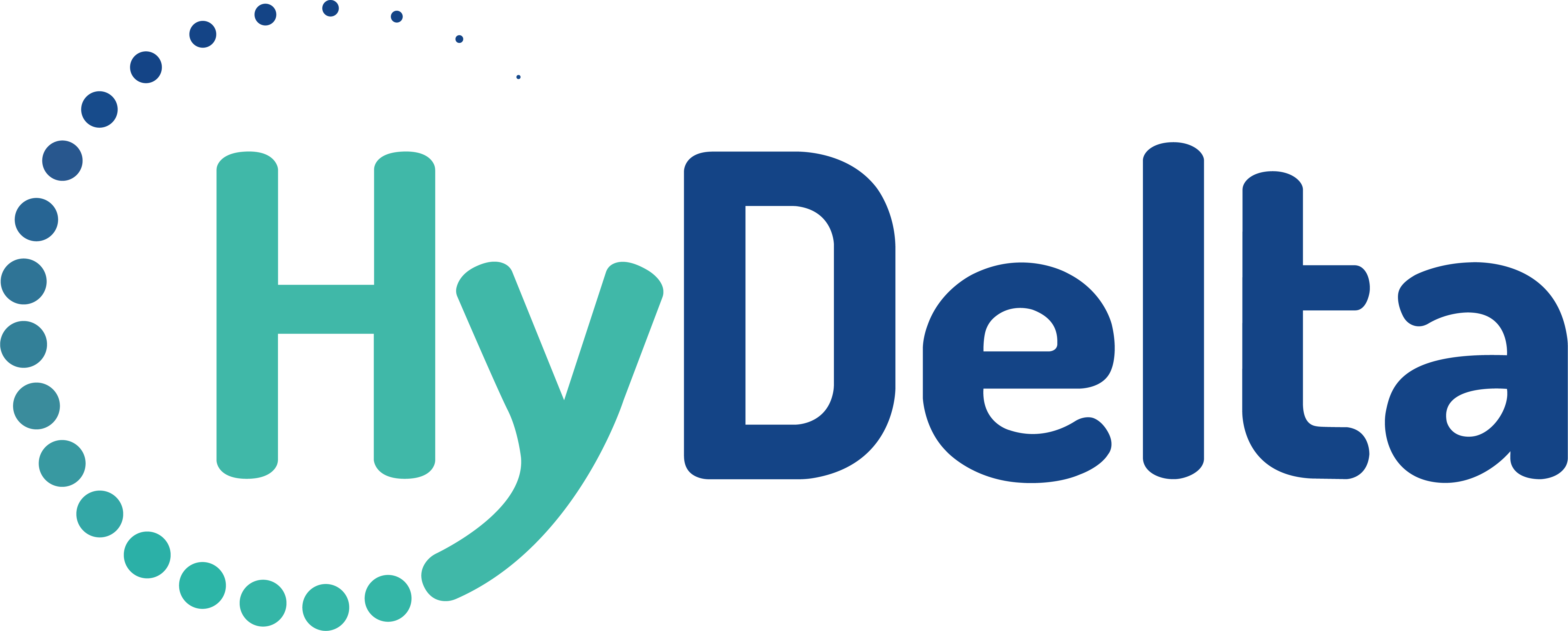HyDelta 2

Research programme
The HyDelta programme is divided into Work Packages (WPs). Below is an overview of the research topics, with a link to a short description of each respective work package:
- Economic aspects of the hydrogen system
- Hydrogen safety in the gas grid
- Hydrogen and transport assets
- Social aspects of hydrogen
Below you can find a list of our presentations, webinars, and summary documents, as well as a link to download them:
| Number | Deliverable title | Publication date | Link |
|---|---|---|---|
| Webinar | Economic aspects of the hydrogen system - midterm progress and key results | 03-11-2022 | Link |
| Webinar | Hydrogen safety in the gas grid - midterm progress and key results | 15-11-2022 | Link |
| Webinar | Hydrogen and transport assets - midterm progress and key results | 29-11-2022 | Link |
| Webinar | Social aspects of hydrogen - midterm progress and key results | 08-12-2022 | Link |
Economic aspects of the hydrogen system
Below is a list of deliverables resulting from the aforementioned work packages, as well as a link to download them (when available):
WP2: Modeling hydrogen market dynamics in an integrated energy system
Summary: Techno-economic modelling to elucidate at which location(s) in the Netherlands can hydrogen production be feasible, and where can it create high market value for producers and consumers.| Number | Deliverable title | Publication date | Link |
|---|---|---|---|
| D2.1 | Drivers of renewable hydrogen production in the Dutch integrated energy system | 02-06-2023 | Link |
| D2.2 | Hydrogen in the energy system: value for energy transport infrastructure and its users | 17-07-2023 | Link |
WP3: Risks, uncertainty, and collaboration in the hydrogen-based value chain
Summary: Increase the understanding regarding the effects of risk, uncertainty and actor collaboration on decisions related to deployment of flexible power-to-hydrogen conversion in energy systems at different levels.| Number | Deliverable title | Publication date | Link |
|---|---|---|---|
| D3.1 | Case studies of interest regarding risks and uncertainty in the hydrogen value chain | 09-01-2023 | Link |
| D3.2 | Individual and system risks in hydrogen value chains: methodology and case studies | 08-05-2023 | Link |
| D3.3 | Individual and system uncertainties in hydrogen value chain developments | 11-07-2023 | Link |
| D3.4 | Technical analysis of hydrogen supply chains – factsheets (update 2023) | 07-07-2023 | Link |
WP4: Hydrogen blending and congestion management
Summary: Elucidate the potential for local hydrogen production and consumption in areas of the Netherlands dealing with congestion of the electricity network, and what factors play here a critical role| Number | Deliverable title | Publication date | Link |
|---|---|---|---|
| D4.1 | Introducing hydrogen in decentral end-user areas to deal with e-grid congestion in the Netherlands | 06-12-2022 | Link |
| D4.2 | Cost-benefit analysis of various short-term supply-side E-grid flexibility options in local areas in comparison to conventional grid-expansion techniques | 07-07-2023 | Link |
| D4.3 | Report on the main policy implications of the potential of hydrogen for regional electricity grid congestion mitigation | 07-07-2023 | Link |
Hydrogen safety in the gas grid
Below is a list of deliverables resulting from the aforementioned work packages, as well as a link to download them (when available):
WP5: Safe operations of the high-pressure transmission grid
Summary: Determine how operational H2-pipelines can be operated and maintained safely e.g., can recompression be used? Is it possible to flare or blow-off? Which working procedures shall be followed? What equipment is required?| Number | Deliverable title | Publication date | Link |
|---|---|---|---|
| D5.1 | Venting and flaring of hydrogen in a high-pressure transmission network | 17-07-2023 | Link |
| D5.2 | A report on how to purge an H2-pipeline based on theoretical and practical research including working procedures | 17-07-2023 | Link |
WP6A: Safety of hydrogen in the distribution grid and built environment
Summary: Carry out tests and continue developing a Quantitative Risk Assessment (QRA) to map the risks of leakages of hydrogen in the built environment and, if necessary, provide recommendations for mitigating actions.| Number | Deliverable title | Publication date | Link |
|---|---|---|---|
| D6A.1 | Outflow experiment results: concentration build-up at leakages between 50 - 1000 dm3/h | 17-07-2023 | Link |
| D6A.2 & D6A.3 | Quantitative Risk Assessment of the distribution grid and built environment in the Netherlands: application and case studies | 22-06-2022 | Link |
| D6A.4 | General recommendations: applicability of QRA tools, detection of hydrogen fires, effectiveness of odorisation, and effect of hydrogen permeation | 09-08-2023 | Link |
WP6B.1: Safety and suitability of gas stations in the distribution grid for hydrogen
Summary: Determine what modifications to the enclosure (the housing) of gas stations are necessary for safe distribution of hydrogen through gas stations: ventilation, adjustments needed, etc.| Number | Deliverable title | Publication date | Link |
|---|---|---|---|
| D6B.1A & D6B.1B | Inventory, modeling and experiments related to ventilation in different types of pressure reducing stations in the distribution (low pressure) grid in the Netherlands, in natural gas and hydrogen atmospheres | 19-07-2023 | Link |
WP6B.2: Safety and suitability of using inflatable gas stoppers in the distribution grid to mitigate a hydrogen leak
Summary: To gain insight into the risks associated with the use of inflatable gas stoppers for the temporarily closing of a hydrogen gas pipe, including any additional requirements| Number | Deliverable title | Publication date | Link |
|---|---|---|---|
| D6B.2A & D6B.2B | Report on ignition scenarios and experiments during the use of inflatable gas stoppers to mitigate natural gas and hydrogen leaks in the low pressure gas distribution grid | 03-05-2023 | Link |
WP9: Implications of hydrogen in combustion use - NOx effects
Summary: Map current successfully applied NOx-reducing strategies and elucidate the basis for design rules for hydrogen burners applied in high-temperature processes towards mitigating NOx emissions.| Number | Deliverable title | Publication date | Link |
|---|---|---|---|
| D9.1 & D9.2 | Literature research on low NOx hydrogen burners and developing design rules for low NOx burners | 22-05-2023 | Link |
Hydrogen and transport assets
Below is a list of deliverables resulting from the aforementioned work packages, as well as a link to download them (when available):
WP7: Analysis of the conversion of a natural gas distribution network to hydrogen
Summary: Development of a plan for the conversion of a natural gas distribution network to a hydrogen distribution network (from gas receiving station to customers’ gas installations).| Number | Deliverable title | Publication date | Link |
|---|---|---|---|
| D7.1 | Inventory of relevant aspects for conversion of gas distribution networks to hydrogen | 21-07-2023 | Link |
| D7.2 | Concept of a conversion plan of a natural gas distribution network to hydrogen | 21-07-2023 | Link |
WP8: Analyzing digitalization in network management
Summary: Research how digitalization (simulation and decision support tools combined with dedicated sensors) can contribute to an effective transition to hydrogen grids.| Number | Deliverable title | Publication date | Link |
|---|---|---|---|
| D8.1 & D8.2 | State of the art technologies in the current gas grid and gap definition with the future hydrogen grid | 03-01-2023 | Link |
| D8.3 & D8.4 | Simulation of selected cases for digitalisation in a Dutch hydrogen distribution network | 08-06-2023 | Link |
Social aspects of hydrogen
Below is a list of deliverables resulting from the aforementioned work packages, as well as a link to download them (when available):
WP10: Social acceptance for hydrogen transport and storage
Summary: What are the main societal challenges for deploying hydrogen transport/ distribution, storage, and application within the built environment in the Netherlands and how could these challenges be overcome as part of the development and implementation strategy.| Number | Deliverable title | Publication date | Link |
|---|---|---|---|
| D10.1 | Overview from the literature/studies on societal support for new energy technologies and hydrogen in particular. An exploration of the aspects that (in similar circumstances) hinder or accelerate societal embeddedness. | 30-12-2022 | Link |
| D10.2 | Stakeholder perspectives on the societal embeddedness of the development and deployment of hydrogen technologies in the Netherlands | 03-04-2023 | Link |
| D10.3 | Case study report with best practices regarding risk governance and societal embeddedness of innovative energy technologies | 13-04-2023 | Link |
| D10.4 | Synthesis: Towards societal risk governance strategies | 22-06-2023 | Link |
WP11: Labor market and training implications of hydrogen
Summary: An inventarisation and overview of the required (future) skills and available education to match this in the upcoming hydrogen economy, to serve as a starting point to start developing attractive and comprehensive curriculums to train relevant personal in hydrogen technologies and applications.| Number | Deliverable title | Publication date | Link |
|---|---|---|---|
| D11.1 | The future requirements for HBO, WO and postgraduate personnel in the hydrogen industry | 11-08-2023 | Link |

